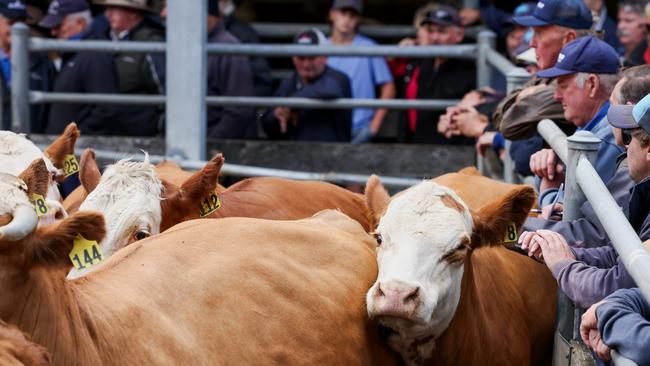Restocker demand driving livestock market revival
Livestock markets have roared back to life in the past month with widespread rainfall “flicking a switch” in the market.
Livestock markets have roared back to life as the barometer of industry confidence shows its total dependence on rainfall.
Both sheep and cattle prices have increased dramatically in the past month, but especially in the past week as restockers entered the market and forced processors to step up to secure supplies.
The reversal in producer fortunes follows widespread rainfall across eastern Australia in recent weeks which defied Bureau of Meteorology forecasts, angering many farmers who had sold stock early.
Nutrien livestock agent Phil Douglas said the turnaround in prices and confidence at last week’s Colac store cattle sale was “like flicking a switch”.
“Talk of dry weather for nine months did the market no favours, but it’s changed a lot in just a month,” Mr Douglas said. “We had cows and calves that were offered $1300-$1500 in the paddock a month ago — they averaged $2200.”

According to the BOM, rainfall totals across parts of Queensland, NSW, Victoria, South Australia during November were in the top 10 per cent on record.
In southeast Australia, Bega on the NSW South Coast measured 230mm during November — three-and-a-half-times its monthly average while Deniliquin in the Riverina recorded 185mm or four times what it would normally expect. There were also 100mm-plus totals at Gelantipy, Omeo, Naracoorte in South Australia, Wagga Wagga, Temora, Bombala, Yarram, Swan Hill and Bairnsdale.
The benchmark Eastern Young Cattle Indicator’s stellar rise has seen it lift 176c/kg carcass weight in the past month or 46 per cent, and lifted 10c/kg in the past week. The EYCI slumped to 349c/kg in late October after beginning the year at 850c/kg. It hit a record 1192c/kg in January last year.
But it’s not only cattle that are benefiting, with all sheep and all cattle indicators rising in the past week.
According to the National Livestock Reporting Service, cattle prices rose up to 28c/kg liveweight with restocker steers recording the biggest jump in values. Prices for sheep and lambs increased up to 49c/kg.
Mecardo managing director Robert Herrmann said he believed livestock markets had “passed the bottom” and while the only measurable factor different now to a month ago was rain, sentiment about buying stock had changed.

Mr Herrmann said the major factor influencing the EYCI was restocker demand, which not only pushed it to extreme levels during 2022 but also caused it to dive this year.
“Both extremes (high and low) were driven by demand or lack of demand from producers,” he said.
“The thing to learn from what’s happened this year is that you should stand back and think about your own business and make decisions rather than follow the herd.”
Mr Douglas said some buyers at last week’s 1650-head Colac sale came with a budget in mind but went home empty handed.
“If you look at where the cattle went, yes some went into NSW but there were plenty of pens they bid on too that they didn’t get,” he said. “Prices are on the rise but it’s not like they are great, just a whole lot better.”
Some producers say confidence in the market was eroded by the Bureau of Meteorology’s warning of a looming El Nino for months, as it moved its forecast from watch to alert during the year before finally confirming the event in September.
Walwa Angus breeder Michael Gadd said he had fallen victim to concerns about the season and sold cattle earlier than normal due to fears it would be dry.
“I was overseas at the time and saw the forecast and thought I should sell some steers,” Mr Gadd said.
“The talk of dry weather did influence what I did, but there was also confidence being ebbed away when you would book cattle in, and then they would push you back and back and we even had loads that were booked in and cancelled.
“It certainly did erode confidence.”

Mr Gadd said it was easy to lay blame with the Bureau of Meteorology, but “as farmers, risk management is part of what we do every day, and if it had been dry this year, it was coming off the back of two very wet years so it’s something we could have managed”.
The lift in rates comes off the back of more positive news for the industry with exports expected to post records this year.
MLA global analyst Tim Jackson said based on provisional data, lamb exports in November were up 30 per cent on last year at 29,869 tonnes, while mutton exports were up 47 per cent from last November to 19,849 tonnes.
“I think the big takeaway from the high export volumes we’ve seen all year is that demand for Australian sheepmeat holds up in periods of high supply, and that Australia’s diversity of export markets is important,” Mr Jackson said.




